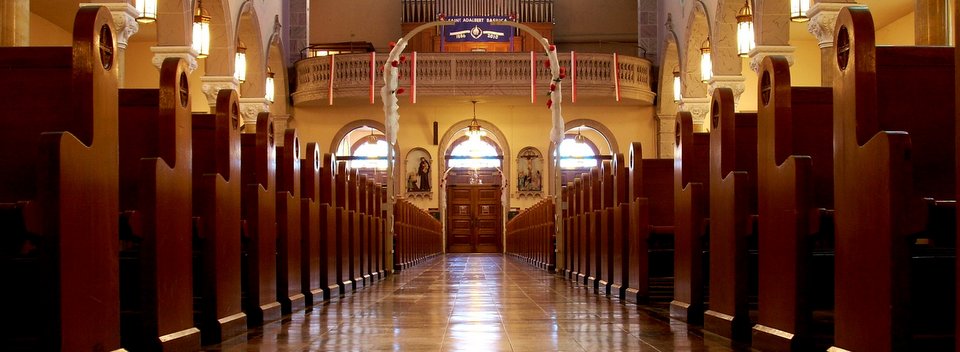
HISTORY
The authoritative rule of the Rev. Jan Pitass at St. Stanislaus, was not to everyone's liking. Those who had different views and those who resided further from the church complex sought permission to establish a second Polish parish in buffalo. This was not to Pitass' approval nor that of the Bishop, Stephan Ryan. After an ill fated attempt to build another church failed, Vatican intervention was sought and successfully. In Sept of 1886, Bishop Ryan appointed Rev Antoni Klawitter, of St. Stanislaus a new parish which was named for the Polish saint, Adalbert. the first pastor a most colorful personality had envisioned a social complex for the new parish and its property. When a suspicious fire destroyed the church, the disillusioned Klawitter left the area, heading West. For the next six years a continual change of pastors came to the young parish. The far reaching arm of Jan Pitass brought about a rapid succession of priests. In 1895, the young Tomasz Flaczek, a fellow Silesian, was appointed pastor. This appointment so infuriated the parishioners of St. Adalbert to that protests which turned to violent, bloody brawls. The young pastor was threatened and sought refuge at St. Stanislaus until it was safe for him to return to his parish. Those dissatisfied organized and built another church just a block away, calling it, Holy mother of the Rosary. Their former pastor and founder of St. Adalbert was asked to take charge of the parish. Since this was done without diocesan approval the Bishop would not bless the church or the congregation. This parish became one of the many Independent churches that sprang up in this time period in several Polish American conclaves.
The eventful and long pastorate of Rev. Flaczek ended in 1926. During his term many improvements and successes occurred. A new and modern brick schoolhouse was built to accommodate the over 1,000 students, as well as a new rectory. A native son of the parish, Jozef Mazur, an ecclesiastical painter, decorated the church. Stained glass windows were imported from Germany and installed. A rare and special designation bestowed on the parish occurred in 1907, when the Vatican proclaimed St. Adalbert a basilica, the first in the USA. Upon the death of Rev. Flaczek, Franciszek Kaluzny became pastor. The magnificent main altar of imported marble was installed with funds left the parish for this purpose in the last will of Fr. Flaczek. Rev. Kaluzny was a talented author and devoted much time to his writing besides conduction devotional ceremonies in the parish.
Following the Second World War, the parish began to notice the younger families leaving the Eastside and by 1970 the effect became considerable. The once Polish stronghold was becoming less Polish and more a minority neighborhood. The shift in population not only brought about the closing of the parish school in 1985 but also saw the establishment of a parish outreach center - St. Adalbert's Response to Love Center - serving the needs of the whole neighborhood. The Felician Sisters, involved for so long in the parish life took on a new ministry. Under the leadership of pastor, Joseph Bialek, the parish observed its centennial. Upon his death in 1996, the Rev. Tadeusz Bocianowski, a native of Poland, became pastor, serving until 2012.
In 2009, St. Adalbert's Parish held its first all-year reunion, which attracted 750 people to a special Mass followed by a reception for over 450 people at the Harvey Morin VFW Post in West Seneca.
St. Adalbert's Parish was merged with neighboring St. John Kanty Parish in 2011. Regular weekend Masses at held at St. John Kanty Church, while Mass is celebrated at St. Adalbert's on special occasions.
In 2016, St. Adalbert's former rectory was transformed into the Mother Teresa Home, a haven for pregnant women operated by the Diocesen Office of Pro-Life Activities. Following a special Mass in St. Adalbert Basilica, the ribbon-cutting and dedication were held on August 25, 2016.

